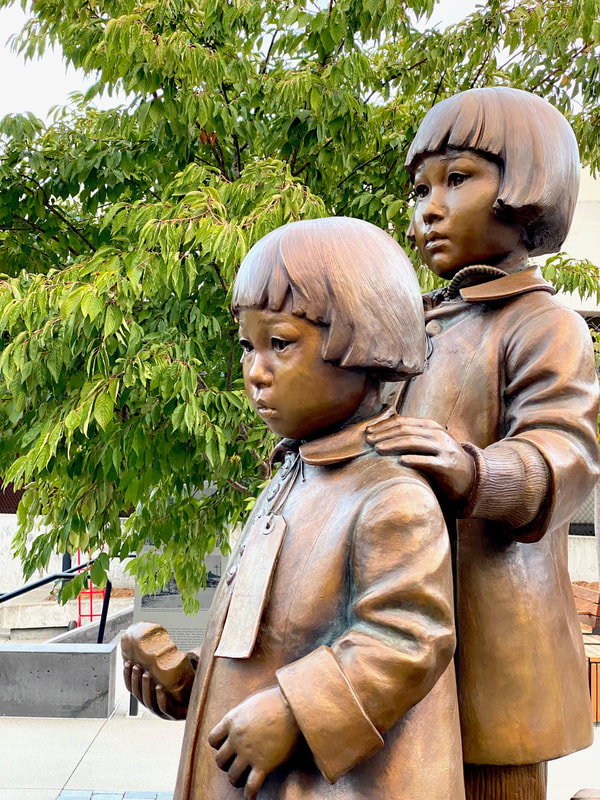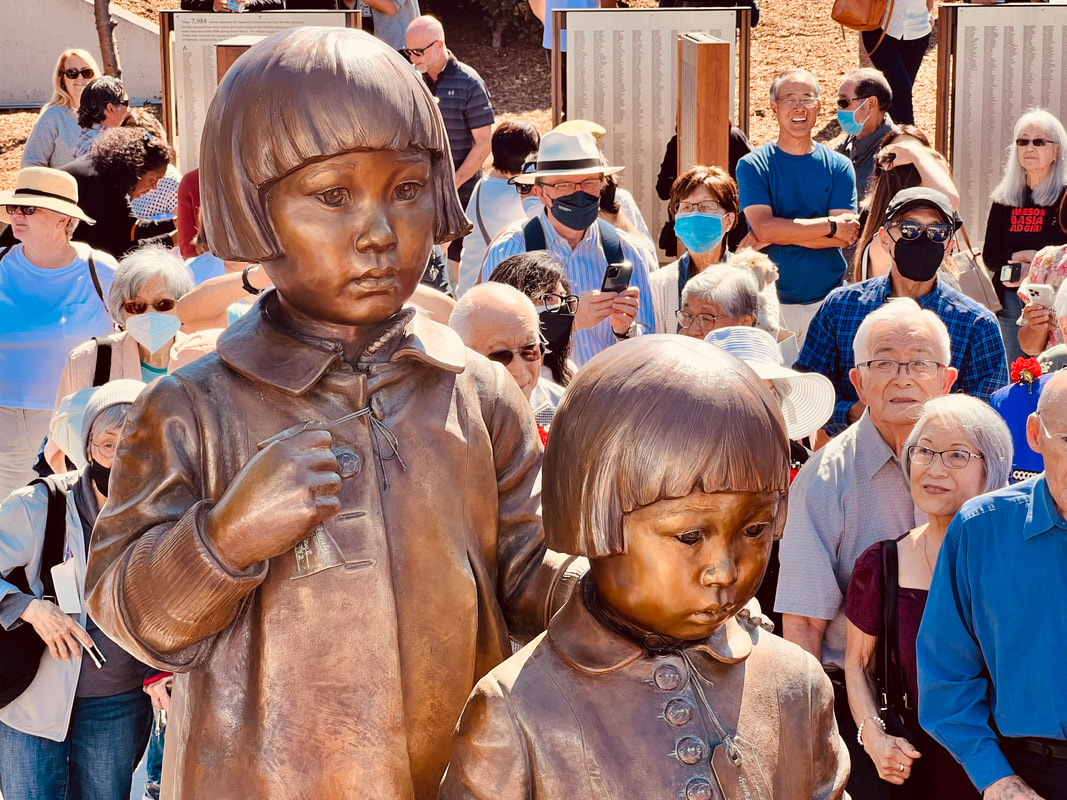|
The Tanforan Memorial sculpture was commissioned to serve as both a memorial and a record of a historic event. It recreates in sculptural form members of a Japanese-American family who were photographed in 1942 by Dorothea Lange. The Lange photos documented families waiting for the buses at Tanforan, and the memorial committee wanted a close recreation of those family members based on the photos. For the proposal, I was invited to choose which photos and which family members might be the focus of my preliminary drawings. So this was a straight-forward assignment without much room for modification.
The purpose of the sculpture is chiefly to memorialize those who had been ordered to assemble at the Tanforan site to be incarcerated in faraway camps for the duration of WW II. Some 8000 men, women and children did so at the Tanforan site. They showed up in their Sunday best, with what remained of their worldly belongings in suitcases, and with government-issued I.D. tags at their necks. Each family was issued a number. From there they were bused to the local racetrack where they were kept for months in horse stalls while the government built the inland camps — camps that would end up housing about 120,000 innocent people. At the time I heard of this commission, I knew little about the internments, only that they’d occurred. My Canadian education and exposure to American culture didn’t illuminate this aspect of the war. So my early thoughts and drawings were inspired primarily by my basic sense of outrage upon learning the details of what happened, and sadness for the victims. Those feelings served as a kind of fuel for the commission, but it was what I learned about the subject and my conception of it that guided my work. Once I zeroed in on the specific people who I would recreate, the realness of the subject came into full focus. The two Mochida sisters stood out for me as reflecting the victims’ innocence and representing the more general subject of the innocent confronted by force. The youngest expressed the elementary response of confusion, fear, and of longing for home — as a little child would feel in that situation. But a spectacle of fear and confusion could not imply the full nature of what was being depicted. To fully understand the subject, I turned to researching the incarcerations. The accounts by former incarcerees and their families revealed life in and after the camps. A picture emerged of decent, freedom-loving people who, through no fault of their own, were violated by their government. That government was not an all out tyranny, but a fear-driven, collectivist administration that flouted individual rights in an otherwise free society. The victims did their best to bear up and looked to restoring their lives after the war. They seemed to count on America being a country in which the individual is ultimately free to flourish. They viewed what was done to them as an aberration to be endured and overcome. And they were right. They were violated in America, not Soviet Russia, not Nazi Germany, Imperialist Japan, modern China, or any other tyranny in which they would have been utterly doomed. At least in America they had a future life. Throughout their incarceration they upheld their standards of life as best they could, and after the war they reclaimed their lives and flourished. So these two children did not represent doomed, pathetic victims. Victims, yes. Pathetic? No. They had a life ahead of them in a world that they and other free people would build. The victims’ benevolence, their dignity and resolute love of their own lives — all of that had to be in this monument, not just fear and a child’s longing to go home. If the monument merely conveyed pathos, it would not be truthful. So I turned to the older girl who I thought offered more opportunity to present a resolute figure. While looking into what she did as they stood waiting for the bus, I noticed in one of the Lange photos that another child was fidgeting with her I.D. tag. I imagined that instead of absent-mindedly fiddling with the tag, the child could pull on it in a more deliberate way, as though she wanted to pull it off. That was the gesture I was looking for. I gave that to the older girl. She pulls on her tag in a calm gesture of defiance. It does not belong on her and she wants it off. She is resolute because she senses that the tag does not belong and that it will come off. She is not happy, but, importantly, she is not afraid. She lightly touches her sister's shoulder to protect and comfort her. While the youngest looks down in confusion and sadness, the older girl looks to their horizon — to their future life in freedom.
1 Comment
10/19/2022 03:09:35 am
Entire federal option buy.
Reply
Leave a Reply. |
Sandra J. Shaw
Sculptor. Art instructor Archives
September 2022
Categories |



 RSS Feed
RSS Feed